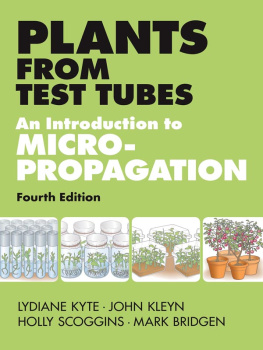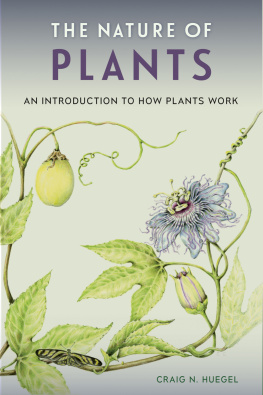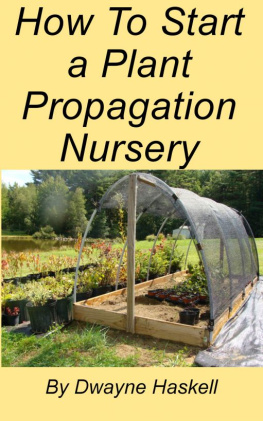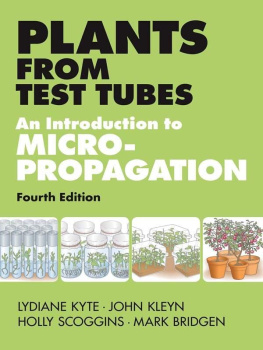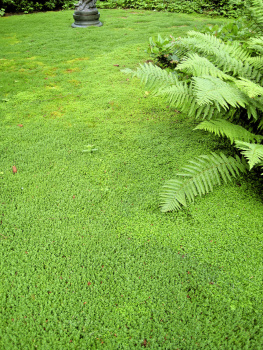
PLANTS
FROM TEST TUBES

: banana.
Photo and illustration credits appear on .
Copyright 2013 by Lydiane Kyte, John Kleyn, Holly Scoggins, and Mark Bridgen. All rights reserved.
Published in 2013 by Timber Press, Inc.
The Haseltine Building | 6a Lonsdale Road |
133 S.W. Second Avenue, Suite 450 | London NW6 6RD |
Portland, Oregon 97204-3527 | timberpress.co.uk |
timberpress.com |
Printed in China
Book design by Susan Applegate
Library of Congress Cataloging-in-Publication Data
Plants from test tubes: an introduction to micropropagation/Lydiane Kyte . [et al.].4th ed.
p. cm.
Includes bibliographical references and index.
ISBN 978-1-60469-206-8
1. Plant micropropagationLaboratory manuals. 2. Plant tissue cultureLaboratory manuals. I. Kyte, Lydiane.
SB123.6.K98 2013
631.53dc23 2012050583
A catalog record for this book is also available from the British Library.
Contents
Cucumis sativus, garden cucumber
Pelargonium graveolens, scented geranium
Preface to the Fourth Edition
Long before tissue culture was widely practiced, Timber Press recognized the need for a tissue culture primer that could serve the general public and commercial horticulture. To fill that need, Plants from Test Tubes was published in 1983. Author Lydiane Kyte drew from her practical experience in the industry to create an accessible yet thorough review of micropropagation techniques, along with hands-on projects. For the third edition, she collaborated with microbiologist John Kleyn to enhance sections related to contamination, as she noted, the bane of all tissue culture.
Plants from Test Tubes now celebrates its 30th year in print and has gone through numerous printings with a worldwide distribution. Mark Bridgen and I have sought to update the science and resources while retaining much of Lydiane and Johns original explanations and trademark conversational, non-technical style.
My contribution to the fourth edition comes on behalf of nursery and greenhouse propagators and growers. New plant introductions drive the market, and the importance of micropropagation cannot be overstated in bringing new and improved plant selections to the ornamental plant market. Mark brings years of laboratory and teaching experience. We have also sought to thoroughly update the resources presented, accounting for corporate mergers and other changes, and have included web URLs.
I thank those in academia and industry who graciously contributed to this revision: research technician Suzanne Piovanno, Gary Seckinger of PhytoTechnology Laboratories, and George Chan of LumiGrow. Thanks also to my patient partner, Joel Shuman. Mark Bridgen thanks his friend and colleague, plant pathologist Margery Daughtrey. To those who contributed illustrations for this new edition we express our appreciation, especially to AG3, Briggs Nursery, Terra Nova Nurseries, and Thermo Fischer Scientific. Award-winning scientific artist Marjorie Leggitt provided the many new drawings. Finally, our thanks to the many devotees of previous editions, and those who continue to utilize and recommend Plants from Test Tubes as a gateway to the fascinating world of micro-propagation.
HOLLY SCOGGINS
Preface to the Third Edition
The first edition of Plants from Test Tubes came about as a result of the realization by Timber Press that there was a need for a tissue culture primer that could serve the general public and commercial horticulture, areas where tissue culture was not yet widely practiced. The response was overwhelming. The book found its way beyond the United States and Canada, appearing in Egypt, in Brazil, in Australia, in India, and in Europe, where it was even translated into Danish.
The basics of tissue culture have changed very little in the past 20 years. A reliance on sterile technique and on variations of Murashige and Skoogs medium formula continue to be focal points of successful micropropagation. But even in the academic world, where sterile technique is commonplace and articles in technical journals are readily available, the book has proven useful as an introductory text.
This third edition was launched due to an outcry of demand when the second edition went out of print. (The demand echoed in a tissue culture network.) It seemed appropriate to widen the scope of the book and to touch on the explosion in the related field of biotechnology, a field that depends on the use of tissue culture in such areas as the multiplication of transformed plants. Cell culture is also introduced in this edition, as further research suggests the numerous applications of that procedure in industry.
Without the encouragement and contribution of John Kleyn, my collaborator, this edition would not even have been attempted. As a microbiologist, professor, commercial tissue culturist, and consultant, he brings a new dimension to the book. Specifically, he suggests to the reader methods of preventing and identifying microbial contaminants, the bane of all tissue culture.
For their encouragement and helpful suggestions, I would like to thank the many devotees of previous editions and my associates in the International Plant Propagators Society. John Kleyn joins me in gratitude for the patience of our respective spouses, Bob Kyte and Jan Kleyn.
LYDIANE KYTE
Preface to the First and Second (Revised) Editions
This book was born out of a personal need for such a book when I started into tissue culture. It is, at best, a starting point and, hopefully, a partial answer for those who ask, What is tissue culture? As a grower, is micropropagation something I can and want to do? And, how do I do it?
I would like to acknowledge with gratitude Hudson Hartmann (University of California at Davis) for so generously reading this work, providing useful suggestions, and writing the Foreword; Dale Kester (University of California at Davis) and Gayle Suttle (Microplant Nurseries), who so kindly read the manuscript and assisted with helpful comments; Bruce Briggs (Briggs Nursery), Sarah Upham (Native Plants), and countless others for their encouragement and willingness to share hard-earned information; Richard Abel, editor, for his patience reinforcement, and untiring effort to help make this book a credible reality; and Bob, my husband, for his support assistance, and encouragement.
LYDIANE KYTE
ONE
THE BASICS OF TISSUE CULTURE


Figure 1-1. The 5 stages of micropropagation.
1 Overview
Plant tissue culture is a field of many facets. Its applications vary from the curious gardener multiplying plants in a modest home kitchen to the renowned scientist working in an elaborate laboratory. It reaches from the orchid hobbyist who has learned to multiply a few personal favorites to a million-dollar industry producing houseplants, ornamentals, and secondary products. Tissue culture is the ever-ready tool for specialists who hybridize plants by either sexual or asexual means. It is a clean and rapid way for genetic engineers to grow material for identifying and manipulating genes or to transfer individual characteristics from one plant to another. It plays a role in a wide array of fields, such as botany, chemistry, physics, genetic engineering, fecular biology, hybrid development, pesticide testing, and food science.
Next page
